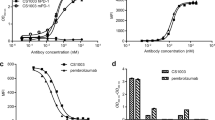Abstract
Purpose
NPC-1C is a chimeric immunoglobulin IgG1 developed from antigen tested in the Hollinshead tumor vaccine trials that recognizes an immunogenic MUC5AC-related tumor-associated antigen. In this article, we describe the pre-clinical characterization of this antibody that is currently being tested in human clinical trials.
Experimental design
The specificity of NPC-1C for pancreatic and colorectal cancer cell lines was tested by flow cytometry assays and immunohistochemical staining. Antibody-dependent cell cytotoxicity was measured using a tumor cell line lysis assay. Anti-tumor efficacy and biodistribution were assessed in nude mice bearing human pancreatic tumor xenografts.
Results
Human tumor cell binding measured by flow cytometry ranged from 52 to 94 % of cells stained positive with NPC-1C in three colorectal and one pancreatic cell lines, while IHC demonstrated staining of 43 % of colon cancers and 48 % of pancreatic cancer tissues, with little or no cross-reactivity of NPC-1C with normal colon or pancreas tissues. In vitro NPC-1C-mediated tumor cell killing occurred in a median of 44.5 % of four colorectal and three pancreatic tumor cell lines. In vivo anti-tumor efficacy in a human pancreatic CFPAC-1 tumor xenograft model was demonstrated with a twofold to threefold reduction in tumor growth in the NPC-1C-treated mice compared to saline and human IgG controls. Pharmacodynamic studies indicate NPC-1C localizes in antigen-positive tumors and has minimal uptake in normal mouse tissues.
Conclusions
NPC-1C, a chimeric monoclonal antibody that reacts with a MUC5AC-related antigen expressed by pancreatic and colorectal tumor tissues, has promising preclinical activity in pancreatic and colorectal adenocarcinoma.




Similar content being viewed by others
References
Conroy T, Desseigne F, Ychou M et al (2011) FOLFIRINOX versus gemcitabine for metastatic pancreatic cancer. N Engl J Med 364(19):1817–1825
Jimeno A, Hidalgo M (2006) Molecular biomarkers: their increasing role in the diagnosis, characterization, and therapy guidance in pancreatic cancer. Mol Cancer Ther 5(4):787–796
Laheru D, Jaffee EM (2005) Immunotherapy for pancreatic cancer science driving clinical progress. Nat Rev Cancer 5(6):459–467
Hollinshead AC, McWright CG, Alford TC, Glew DH, Gold P, Herbeman RB (1972) Separation of skin reactive intestinal cancer antigen from the carcinoembryonic antigen of gold. Science 177(52):887–889
Hollinshead A, Elias EG, Arlen M, Buda B, Mosley M, Scherrer J (1985) Specific active immunotherapy in patients with adenocarcinoma of the colon utilizing tumor-associated antigens (TAA). A phase I clinical trial. Cancer 56(3):480–489
Luka J, Arlen PM, Bristol A (2011) Development of a serum biomarker assay that differentiates tumor-associated MUC5AC (NPC-1C ANTIGEN) from normal MUC5AC. J Biomed Biotechnol 2011. Article ID 934757. doi:10.1155/2011/934757
Qi CF, Nieroda C, De Filippi R, Greiner JW, Correale P, Schlom J, Tsang KY (1995) Macrophage colony-stimulating factor enhancement of antibody-dependent cellular cytotoxicity against human colon carcinoma cells. Immunol Lett 47(1):15–24
Jonker DJ, O’Callaghan CJ, Karapetis CS et al (2007) Cetuximab for the treatment of colorectal cancer. N Engl J Med 357(20):2040–2048
Van Cutsem E, Peeters M, Siena S et al (2007) Open-label phase III trial of panitumumab plus best supportive care compared with best supportive care alone in patients with chemotherapy-refractory metastatic colorectal cancer. J Clin Oncol 25(13):1658–1664
Hurwitz H, Fehrenbacher L, Novotny W et al (2004) Bevacizumab plus irinotecan, fluorouracil, and leucovorin for metastatic colorectal cancer. N Engl J Med 350(23):2335–2342
Lau SK, Weiss LM, Chu PG (2004) Differential expression of MUC1, MUC2, and MUC5AC in carcinomas of various sites: an immunohistochemical study. Am J Clin Pathol 122:61–69
Baldus SE, Engelmann K, Hanisch FG (2004) MUC1 and the MUCs: a family of human mucins with impact in cancer biology. Crit Rev Clin Lab Sci 41:189–231
O’Donnell R, Breen D, Wilson S, Djukanovic R (2006) Inflammatory cells in the airways in COPD. Thorax 61(5):448–454
Kim GE, Bae HI, Park HU et al (2002) Aberrant expression of MUC5AC and MUC6 gastric mucins and sialylated antigen in intraepithelial neoplasms of the pancreas. Gastroenterology 123:1052–1060
Iacobuzio-Donahue CA, Ashfaq R, Maitra A et al (2003) Highly expressed genes in pancreatic ductal adenocarcinomas A comprehensive characterization and comparison of the transcription profiles obtained from three major technologies. Cancer Res 63:8614–8622
Byrd JC, Bresalier RS (2004) Mucins and mucin binding proteins in colorectal cancer. Cancer Metastasis Rev 23:77–99
Rahn JJ, Dabbagh L, Pasdar M, Hugh JC (2001) The importance of MUC1 cellular localization in patients with breast carcinoma: an immunohistologic study of 71 patients and review of the literature. Cancer 2001(91):1973–1982
Khodarev N et al (2009) MUC1-induced transcriptional programs associated with tumorigenesis predict outcome in breast and lung cancer. Cancer Res 69:2833–2837
Chen Y et al (2007) Armed antibodies targeting the mucin repeats of the ovarian cancer antigen, MUC16, are highly efficacious in animal tumor models. Cancer Res 67:4924–4932
Hagenbeek A (2011) VIII. Radioimmunotherapy in malignant lymphoma: an underused tool? Ann Oncol 22(suppl 4):iv51–iv53
Verma S, Miles D, Gianni L et al (2012) Trastuzumab emtansine for HER2-positive advanced breast cancer. N Engl J Med 367(19):1783–1791
Acknowledgments
Precision Biologics (Andrew Bristol, Olga Saric, Xue-Ping Wang, Alex Dubeykovskiy, Philip Arlen); T32 Training Grant (Sandip Patel).
Conflict of interest
No financial conflicts of interest related to this work to disclose.
Author information
Authors and Affiliations
Corresponding author
Electronic supplementary material
Below is the link to the electronic supplementary material.
Rights and permissions
About this article
Cite this article
Patel, S.P., Bristol, A., Saric, O. et al. Anti-tumor activity of a novel monoclonal antibody, NPC-1C, optimized for recognition of tumor antigen MUC5AC variant in preclinical models. Cancer Immunol Immunother 62, 1011–1019 (2013). https://doi.org/10.1007/s00262-013-1420-z
Received:
Accepted:
Published:
Issue Date:
DOI: https://doi.org/10.1007/s00262-013-1420-z




